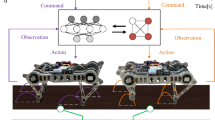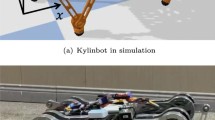Abstract
In this paper an experiment of human locomotion was carried out using a motion capture system to extract the human gait features. The modifiable key gait parameters affecting the dominant performance of biped robot walking were obtained from the extracted human gait features. Based on the modifiable key gait parameters and the Allowable Zero Moment Point (ZMP) Variation Region (AZR), we proposed an effective Bio-inspired Gait Planning (BGP) and control scheme for biped robot towards a given travel distance D. First, we construct an on-line Bio-inspired Gait Synthesis algorithm (BGSN) to generate a complete walking gait motion using the modifiable key gait parameters. Second, a Bio-inspired Gait Parameters Optimization algorithm (BGPO) is established to minimize the energy consumption of all actuators and guarantee biped robot walking with certain walking stability margin. Third, the necessary controllers for biped robot were introduced in briefly. Simulation and experiment results demonstrated the effectiveness of the proposed method, and the gait control system was implemented on DRC-XT humanoid robot.
Similar content being viewed by others
References
Kuo D. Choosing your steps carefully. IEEE Robotics & Automation. Magazine, 2007, 14, 18–29.
Hirai K. The Honda humanoid robot: Development and future perspective. Industrial Robot, 1999, 26, 260–266.
Park I, Kim J, Oh J. Online walking pattern generation and its application to a biped humanoid robot-KHR-3(HUBO). Journal of Advanced Robotics, 2007, 22, 159–190.
Kaneko K, Kanehiro F, Kajita S, Yokoyama K, Akachi K, Kawasaki T, Ota S, Isozumi T. Design of prototype humanoid robotics platform for HRP. Proceedings of IEEE/RSJ International Conference on Intelligent Robots and Systems, Lausanne, Switzerland, 2002, 3, 2431–2436.
Öberg T. Motion analysis in clinical biomechanics. Biomechanics of Musculoskeletal System-Medical Robotics, Polish Academy of Science, Warsaw, 2000.
Vukobratovic M, Frank A A, Juricic D. On the stability of biped locomotion. IEEE Transactions on Biomedical Engineering, 1970, 17, 25–36.
Kajita S, Kanehiro F, Kaneko K. The 3D linear inverted pendulum mode: a simple modeling for a biped walking pattern generation. Proceedings of IEEE/RSJ International Conference on Intelligent Robots and Systems, Maui, Havaii, USA, 2001, 239–246.
Kajita S, Kanehiro F, Kaneko K. Biped walking pattern generation by using preview control of zero-moment point. IEEE International Conference on Robotics and Automation (ICRA), Taipei, Taiwan, 2003a, 1620–1626.
Kajita S, Morisawa M, Miura K. Biped walking stabilization based on linear inverted pendulum tracking. Proceedings of IEEE/RSJ International Conference on Intelligent Robots and Systems, Taipei, Taiwan, 2010, 4489–4496.
Luo X, Xu W L. Planning and control for passive dynamics based walking of 3D biped robots. Journal of Bionic Engineering, 2012, 9, 143–155.
Huang Q, Yokoi K. Planning walking patterns for a biped robot. IEEE Transactions on Robotics and Automation, 2001, 6, 280–289.
Xu W, Huang Q, Li J, Yu Z, Chen X, Xu Q. An improved ZMP trajectory design for the biped robot BHR. Proceedings of IEEE International Conference on Robotics and Automation (ICRA), Shanghai, China, 2011, 569–574.
Santacruz C, Nakamura Y. Analytical real-time pattern generation for trajectory modification and footstep replanning of humanoid robots. Proceedings of IEEE/RSJ International Conference on Intelligent Robots and Systems, Algarve, Portugal, 2012, 2095–2100.
Goswami D, Prahlad V, Kien P D. Genetic algorithm-based optimal bipedal walking gait synthesis considering tradeoff between stability margin and speed. Robotica, 2009, 27, 355–365.
Dau V H, Chew C, Poo A. Achieving energy-efficient biped walking trajectory through GA-based optimization of key parameters. International Journal of Humanoid Robotics, 2009, 6, 609–629.
Liu Z, Wang L, Philip Chen C L, Zeng X, Zhang Y, Wang Y. Energy-efficiency-based gait control system architecture and algorithm for biped robots. IEEE Transactions on Systems Man and Cybernetics Part C (Applications and Reviews), 2012, 42, 926–933.
Hyeok-Ki Shin, Byung Kook Kim. Energy-efficient gait planning and control for biped robots utilizing the allowable ZMP region. IEEE Transactions on Robotics, 2014, 30, 986–993.
Shimmyo S, Sato T, Ohinishi K. Biped walking pattern generation by using preview control based on three-mass model. IEEE Transactions on Industrial Electronics, 2013, 61, 5137–5147.
Kajita S, Kanehiro F, Kaneko K, Fujiwara K, Harada K, Yokoi K, Hirukawa H. Biped walking pattern generation by using preview control of zero-moment point. Proceedings of IEEE International Conference on Robotics and Automation (ICRA), Taipei, 2003, 1620–1626.
Geng T, Porr B, Wrgtter F. Fast biped walking with a sensor- driven neuronal controller and real-time online learning. International Journal of Robotics Research, 2006, 25, 243–259.
Tzuu-Hseng S Li, Yu-Te Su, Shao-Hsien Liu, Jhen-Jia Hu, Ching-Chang Chen. Dynamic balance control for biped robot walking using sensor fusion, Kalman filter, and fuzzy logic. IEEE Transactions on Industrial Electronics, 2012, 59, 4394–4408.
Ren L, Qian Z H, R L Q. Biomechanics of musculoskeletal system and its bio-mimetic implications: A review. Journal of Bionic Engineering, 2014, 11, 159–175.
Li T, Marco Ceccarelli, Minzhou Luo, Med Amine Laribi, Said Zeghloul. An experimental analysis of overcoming obstacle in human walking. Journal of Bionic Engineering, 2014, 11, 497–505.
Vanderborght B, Verrelst V, Ham R V, Damme M V, Lefeber D. Objective locomotion parameters based inverted pendulum trajectory generator. Robotics and Autonomous systems, 2008, 56, 738–750.
Luc Boutin, Antoine Eon, Said Zeghloul, Patrick Lacouture. From human motion capture to humanoid locomotion imitation Application to the robots HRP-2 and HOAP-3. Robotica, 2011, 29, 325–334.
Ottaviano E, Ceccarelli M, Palmucci F. An application of CaTraSys, a cable-based parallel measuring system for an experimental characterization of human walking. Robotica, 2010, 28, 119–133.
Chiang M H, Chang F R. Anthropomorphic design of the human-like walking robot. Journal of Bionic Engineering, 2013, 10, 186–193.
Missura M, Behnke S. Lateral capture steps for bipedal walking. Proceedings of IEEE-RAS International Conference on Humanoid Robots, Bled, Slovenia, 2011, 401–408.
NDI, http://www.ndigital.com.
Nahon M, Angeles J. Minimization of power losses in cooperating manipulator. Journal of Dynamic Systems, Measurement, and Control. 1992, 114, 213–219.
Goswami A. Postural stability of biped robots and the foot-rotation indicator (FRI) point. International Journal of Robotics Research, 1999, 18, 523–533.
Zhu C, Byrd R H, Lu P, Nocedal J. Algorithm 778: L-BFGS-B: Fortran subroutines for large-scale bound-constrained optimization. ACM Transactions on Mathematical Software, 1997, 23, 550–560.
Author information
Authors and Affiliations
Corresponding author
Rights and permissions
About this article
Cite this article
Zhu, H., Luo, M., Mei, T. et al. Energy-efficient bio-inspired gait planning and control for biped robot based on human locomotion analysis. J Bionic Eng 13, 271–282 (2016). https://doi.org/10.1016/S1672-6529(16)60300-1
Published:
Issue Date:
DOI: https://doi.org/10.1016/S1672-6529(16)60300-1




